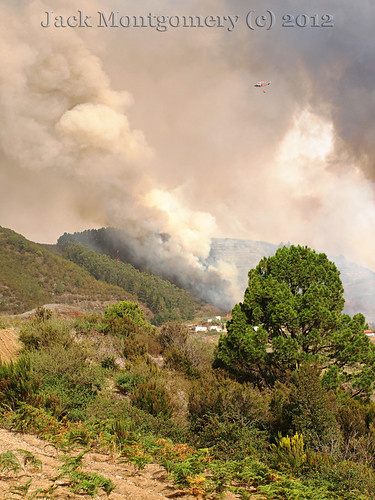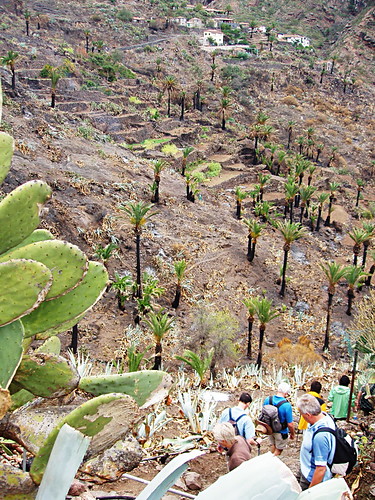As I type this, the Canary Island of La Gomera continues to burn in some of the worst forest fires it has experienced in recent history. For the past 11 days, wildfires have raged through the island, threatening to engulf homes and destroy livelihoods. In the western resort of Valle Gran Rey and the northern town of Vallehermoso, thousands were forced to evacuate their homes as the flames spread, seemingly inexorably down the valleys.
On Tenerife wildfires continue to break out almost daily and again, as I type, helicopters are tackling a blaze in the hills of Los Realejos, just days after fires swept through forests in the El Tanque and Santiago del Valle hills and weeks after serious wildfires in the south of the island.
Why do wildfires happen in the Canary Islands?
The greener Canary Islands of Gran Canaria, Tenerife, La Gomera, La Palma and El Hierro normally experience adequate rainfall in the mountainous interiors during the winter months of November to March, sustaining vast swathes of forests made up of a variety of species including laurels, pines and heathers. Covering 10.7% of the island’s entire surface area, at the heart of La Gomera lies the UNESCO World Heritage site of Garajonay National Park whose laurel trees are believed to be millions of years old and survivors from the Ice Age.
Summers in the Canary Islands are generally hot and dry and lying roughly between 60 and 300 miles from the coast of Africa, they’re susceptible to a weather phenomenon known as Calima, a hot wind which comes in off the Sahara bringing sand-filled air and marked hikes in temperatures. At altitude, Calima brings strong, hot winds and temperatures in excess of 40º Celsius (104ºF) which, combined with dry forests, are a constant summer fire risk.
The winter of 2011-2012 has been the driest on the Canary Islands for more than 70 years and has left the forested interiors of the islands tinder-dry.
How are wildfires in the Canary Islands started?
It’s difficult to say for certain what causes individual fires as we rarely hear of anyone being prosecuted but the main causes of fire outbreaks are undoubtedly negligence and arson.
Although all activities involving naked flames, such as the burning of agricultural rubble, the lighting of barbecues, welding and fireworks are strictly banned in the rural areas of all the islands during the summer months, it’s almost impossible to police the ban. As many of the fires begin during the night, it would suggest that people are using the cover of darkness to undertake banned activities. A carelessly discarded cigarette end, a so-called controlled fire or a wayward firework can quickly take hold and, fanned by hot winds, can become out of control in literally seconds.
Why are wildfires in the Canary Islands so difficult to get under control?
There are many reasons why it’s almost impossible to quickly contain wildfires as they break out.
Firstly, given their volcanic origins, with the notable exceptions of the Eastern Islands of Lanzarote and Fuerteventura, the Canary Islands are very mountainous and scoured with deep ravines known as barrancos which make travel within the interior very difficult and time consuming. La Gomera in particular has barrancos radiating out from its centre like spokes of a wheel, making easy access to the valleys impossible.
Secondly, the islands have little or no natural surface water, most of their water coming from underground streams. Helicopters have to take water from agricultural irrigation tanks maintained by farmers to drop onto affected areas. The further the fire starts from an irrigation tank, the slower the fire-fighting process.
Thirdly are the possible environmental effects of fighting the fire which can be as damaging, or even more so than the fires themselves. When fires get badly out of control, hydroplanes are sent from the Spanish mainland. Filling up by skimming the surface of the sea, the hydroplanes carry over 15,000 litres of water and are the most effective form of fighting the blaze. Unfortunately, sea water would be environmentally devastatingly for La Gomera’s Garajonay National Park and so hydroplanes have to be manually filled with fresh water at the island’s airport, slowing down their work speed.
Do the wildfires on the Canary Islands Affect the Tourism Industry?
The biggest threat to the vital tourism industry on the Canary Islands comes from misreporting, rumours and sensationalism, all of which can take hold every bit as quickly as the wildfires themselves.
In reality, tourists are rarely affected by wildfires as the vast majority of visitors are bound for the tourist resorts of the coast, well away from the fires in the hills and mountains. The hiking industry on La Gomera, Tenerife and Gran Canaria is most likely to be affected but as hiking is largely confined to the winter months, summer temperatures being prohibitive for hiking, the damage comes from fire-charred landscapes marring the natural beauty of the islands.
On Tenerife and Gran Canaria many visitors already on the islands when wildfires break out are far more likely to know of their existence by reading their British newspaper on the beach than by encountering any signs of the fires in their resorts.
Andrea (Andy) Montgomery is a freelance travel writer and co-owner of Buzz Trips and The Real Tenerife series of travel websites. Published in The Telegraph, The Independent, Wexas Traveller, Thomas Cook Travel Magazine, EasyJet Traveller Magazine, you can read her latest content on Google+







Be the first to comment